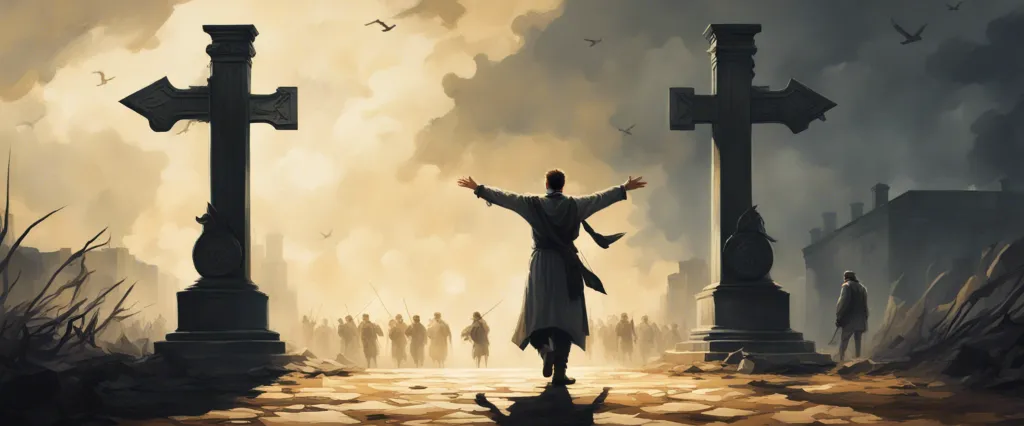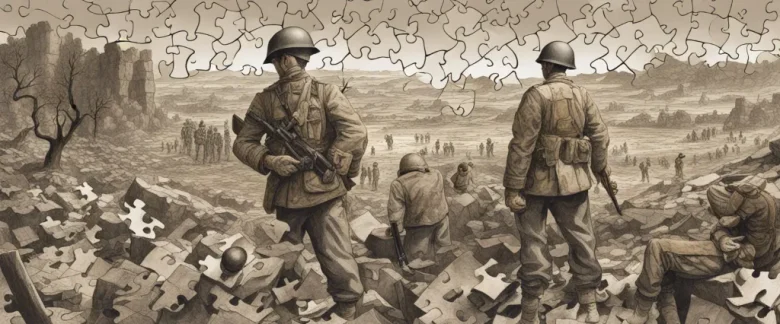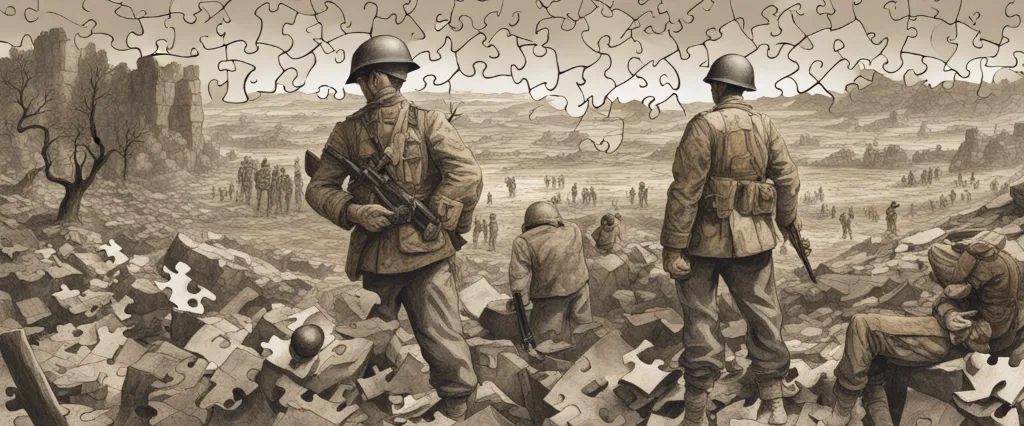In The Vanquished by Robert Gerwarth, an engrossing account of Europe’s post-World War I chaos and its transformative impact, the author delves into the turbulent aftermath of the Great War. Gerwarth, a renowned historian and professor at University College Dublin, specializes in twentieth-century European history and the consequences of war. Drawing on extensive research and a deep understanding of the subject matter, Gerwarth offers a gripping narrative on the forgotten millions who were directly affected by the collapse of empires, the rise of new nations, and the confluence of political, social, and economic upheavals that profoundly shaped the twentieth century.
Chapter 1: The End of World War I
In Chapter 1: The End of World War I of the book “The Vanquished” by Robert Gerwarth, the author examines the tumultuous period following the conclusion of World War I. Gerwarth highlights the confusion, chaos, and unprecedented challenges faced by the defeated nations and their populations.
The chapter begins with the signing of the armistice on November 11, 1918, officially ending the war. While it marked a relief for many, it plunged the defeated nations into uncertainty and bitter disillusionment. Gerwarth emphasizes the loss of millions of lives, the scale of death and destruction, and the severe economic consequences the war had on these nations.
The author underscores the collapse of empires, particularly the Austro-Hungarian, Ottoman, and German empires, which set the stage for further chaos and instability. He explores the complex negotiations and power struggles that took place during the armistice period, as the victors dictated their peace terms to the vanquished.
Gerwarth depicts the fraying of social order in the defeated nations, with rampant violence, lawlessness, and a breakdown of authority. He analyzes the rise of revolutions and civil wars following the armistice, such as the Bolshevik Revolution in Russia and the attempted German Revolution. The author argues that these events were not isolated incidents but part of a broader global upheaval in the aftermath of the war.
Overall, Chapter 1 of “The Vanquished” illustrates the momentous changes and challenges faced by the defeated nations after the end of World War I. Gerwarth emphasizes the dismantling of old world orders, the repercussions of the conflict on the defeated countries, and the subsequent emergence of revolutionary movements that set the stage for a turbulent post-war era.
Chapter 2: The Versailles Treaty and Its Impact
Chapter 2: The Versailles Treaty and Its Impact, in Robert Gerwarth’s book The Vanquished, delves into the consequences of the Treaty of Versailles on the defeated nations following World War I. The treaty, signed in June 1919, aimed to establish peace and hold Germany accountable for the war. However, the author argues that it ultimately planted the seeds of discontent and resentment, leading to further conflicts in Europe.
Gerwarth highlights three key aspects of the treaty’s impact. Firstly, the territorial reconfigurations imposed on Germany and its allies drastically altered the political and social dynamics of these nations. The transfer of German territories to neighboring countries created resentments and nationalist sentiments that would later contribute to the rise of radical ideologies.
Secondly, the enormous reparations imposed on Germany placed an enormous economic burden on the already faltering nation. These reparations, intended to compensate the victors for the war, exacerbated Germany’s economic collapse, leading to hyperinflation and widespread poverty. The author argues that this economic upheaval laid the foundations for social unrest and ultimately contributed to the rise of extremist movements in the 1920s and 1930s, including the Nazi Party.
Lastly, Gerwarth discusses how the treaty impacted the self-perception of the defeated nations, particularly Germany. The Treaty of Versailles imposed a massive political and moral guilt on Germany for the war and positioned the German people as the scapegoats for the entire conflict. This humiliation deeply traumatized the German population, fueling a desire for revenge and demanding a revision of the treaty’s conditions.
In summary, Chapter 2 of The Vanquished explores the consequences of the Treaty of Versailles on the defeated nations, emphasizing how the territorial reconfigurations, reparation payments, and the imposition of guilt contributed to the social, economic, and political instability that would shape Europe in the years to come.
Chapter 3: Revolution and Civil War
Chapter 3 of “The Vanquished” by Robert Gerwarth explores the period of revolution and civil war in Europe during and after World War I. The chapter examines how the consequences of the war gave rise to political unrest, social upheaval, and intense ideological conflicts in several European countries.
Gerwarth begins by illustrating the profound impact of the Russian Revolution of 1917, which set a powerful example for left-wing and revolutionary movements across Europe. As the Bolsheviks pursued their mission of spreading world revolution, the stage was set for clashes between radical political groups and conservative forces.
The chapter then delves into the situation in Germany during the immediate post-war years. The signing of the Treaty of Versailles left many Germans feeling humiliated and resentful, leading to a surge in nationalist sentiments. The Weimar Republic faced resistance from both extreme left-wing and right-wing factions, resulting in a series of uprisings and politically motivated violence.
Moving on to Italy, Gerwarth explores the rise of Benito Mussolini’s Fascist Party. He emphasizes the role of World War I as a catalyst for Mussolini and other veterans, who exhibited disillusionment with the liberal democratic order and sought to establish a more aggressive and authoritarian regime.
The chapter also delves into the Russian Civil War, which erupted in 1918 following the Bolshevik Revolution. Gerwarth discusses the conflict between the Red Army, led by the Bolsheviks, and the anti-Bolshevik White Army, as well as the numerous civil wars and uprisings that ensued in the former Russian Empire.
Overall, Chapter 3 provides a comprehensive account of the revolutionary and civil war turmoil that gripped Europe in the aftermath of World War I. It highlights the interconnectedness of these struggles and the various ideological and political factions that fought for control of their respective nations.
Chapter 4: Nationalism and the Dissolution of Empires

Chapter 4 of “The Vanquished” by Robert Gerwarth, titled “Nationalism and the Dissolution of Empires,” explores the consequences of World War I on the empires that previously dominated Europe and their transformation into nation-states. The chapter primarily focuses on the collapse of the Habsburg, Ottoman, and Romanov empires and the rise of nationalist movements within their territories.
Gerwarth begins by highlighting the tremendous toll the war had on these empires, both economically and politically. He describes how the Habsburg dynasty, ruling over diverse ethnic groups, faced immense challenges in maintaining control. This led to the disintegration of imperial authority and the rise of nationalist movements that aimed to establish independent nation-states.
He then turns to the Ottoman Empire, which had already been in decline prior to the war. The war exacerbated existing tensions and conflicts within the empire, leading to the rise of Turkish nationalism and the successful establishment of the modern Turkish Republic under Mustafa Kemal Atatürk.
Finally, Gerwarth discusses the Romanov Empire and the Russian Revolution. He explores how the war created political upheaval, food shortages, and increasing dissatisfaction among the Russian people, eventually leading to the overthrow of Tsar Nicholas II and the rise of the Bolsheviks.
Throughout the chapter, Gerwarth emphasizes the role of nationalism in the dissolution of these empires. Nationalist movements took advantage of the weakened empires to assert their desires for self-determination and independence. However, the transition from empires to nation-states was not smooth, as it often resulted in violent conflicts, territorial disputes, and the displacement of millions of people.
In summary, Chapter 4 of “The Vanquished” examines the collapse of the Habsburg, Ottoman, and Romanov empires and the subsequent rise of nationalism. It explores the challenges faced by these empires during and after the war, as well as the nationalist movements that emerged, ultimately shaping the new political landscape of Europe.
Chapter 5: Economic Turmoil and Hyperinflation
Chapter 5: Economic Turmoil and Hyperinflation, from the book “The Vanquished” by Robert Gerwarth, delves into the economic hardships and hyperinflation that plagued Europe in the aftermath of World War I. This period was marked by the collapse of economies, social unrest, and the erosion of public trust in political leaders.
Following the devastation of the war, European nations were left with massive war debts and exhausted resources. The Treaty of Versailles, which imposed heavy reparations on Germany, exacerbated these economic challenges. As the German government struggled to pay these reparations, it resorted to printing more money, leading to hyperinflation. Inflation skyrocketed to the point where currency became practically worthless, causing immense suffering for the German population. The chapter highlights the lived experiences of ordinary Germans who were forced to carry wheelbarrows of cash just to buy basic goods, and the resulting erosion of social cohesion and political stability.
Beyond Germany, other countries faced similar economic crises. Austria-Hungary, for example, suffered hyperinflation, labor strikes, and political instability. In addition, countries in Eastern Europe experienced economic turmoil due to the redrawing of borders and the loss of major industrial regions. Overall, this chapter demonstrates how economic devastation led to a breakdown of societal structures, high unemployment rates, rampant inflation, and immense social inequality.
Gerwarth emphasizes that this economic turmoil paved the way for radical ideologies to take root, as disillusioned populations sought alternative solutions. The chapter concludes by foreshadowing the long-term implications of these economic crises, which contributed to the rise of authoritarian regimes and subsequently set the stage for World War II.
Overall, Chapter 5 of “The Vanquished” provides a comprehensive account of the economic turmoil and hyperinflation that engulfed Europe in the aftermath of World War I. It underscores the far-reaching consequences of economic instability, both on national and individual levels, and the pivotal role it played in reshaping European history.
Chapter 6: Rise of Radical Ideologies
Chapter 6: Rise of Radical Ideologies from the book “The Vanquished” by Robert Gerwarth explores the emergence of new and radical ideologies in the immediate aftermath of World War I. This period witnessed profound social, political, and economic transformations, which laid the groundwork for the rise of extremist movements across Europe.
Gerwarth begins by examining the impact of the war on national identities and the destabilization of established political systems. The trauma and disillusionment resulting from the conflict created fertile ground for radical ideas to flourish. He discusses the growth of nationalist movements, often infused with ethnic or racial prejudices, as well as the rise of revolutionary socialist and communist organizations across Europe.
The chapter also delves into the political chaos and violence that engulfed several European countries. Gerwarth analyzes the Russian Revolution and its impact on neighboring countries, which led to a wave of communist uprisings. He also discusses the establishment of a short-lived communist government in Munich, the Spartacist uprising in Germany, and the attempted socialist revolution in Hungary led by Béla Kun.
Moreover, Gerwarth explores the connections between these various radical movements. He highlights the role of Russian Bolsheviks in exporting communist ideology to other countries and the formation of the Comintern, an international communist organization. He also outlines the threat posed by fascist movements, particularly in Italy and Germany, as these radical nationalist groups gained popularity and sought to establish authoritarian regimes.
Throughout the chapter, Gerwarth emphasizes how the chaos and uncertainty of the post-war period provided a fertile breeding ground for radical ideologies across Europe. He illustrates how these ideologies would ultimately shape the course of the 20th century, leading to further conflict and divisions within societies.
Chapter 7: Rebuilding and Recovery
Chapter 7 of the book “The Vanquished” by Robert Gerwarth focuses on the period of rebuilding and recovery in the aftermath of World War I. It delves into the challenges faced by the defeated nations, particularly Germany, Austria-Hungary, Turkey, and Bulgaria.
The chapter begins by highlighting the devastation caused by the war, with vast stretches of territories in ruins and economies in shambles. The defeated nations had to grapple with the loss of millions of lives, extensive territorial changes, and an urgent need to rebuild their shattered societies.
Gerwarth explores the political landscape and the emergence of new republics in Germany, Austria-Hungary, and Turkey, and the significant challenges they faced in establishing stable governments. The fragmentation of these nations, combined with the rise of radical ideologies, posed a threat to their attempts at rebuilding. Political unrest, social upheaval, and economic hardships further complicated the recovery process.
The author discusses the impact of the Treaty of Versailles on the defeated nations, particularly Germany. The harsh terms imposed on Germany, including heavy reparations and territorial losses, further strained their economic and political stability. This exacerbated social tensions and fueled resentment among the populace, setting the stage for future conflicts.
Additionally, Gerwarth highlights the emergence of new nationalist ideologies and their influence on the rebuilding efforts. These ideologies sought to redefine national identities and delegitimize the defeated nations, perpetuating divisions and hindering the recovery process.
Overall, Chapter 7 emphasizes the immense challenges the defeated nations faced in rebuilding after World War I. It sheds light on the complex political, economic, and social dynamics that shaped this period and sets the stage for future developments that paved the way for World War II.

Chapter 8: Legacy and Lessons
Chapter 8, “Legacy and Lessons” of Robert Gerwarth’s book “The Vanquished,” examines the aftermath and long-term consequences of World War I. This chapter explores how the war set the stage for political, social, and economic transformations across Europe, leading to the rise of fascism and communism.
Gerwarth begins by discussing the impact of the war on individuals and societies. He highlights the profound trauma experienced by soldiers and civilians who had lived through the horrors of the conflict. He also addresses how the war disrupted traditional norms and hierarchies, leading to an upsurge in political radicalism and social unrest.
The author then delves into the political aftermath of the war. The collapse of empires, such as the Austro-Hungarian and Ottoman empires, created power vacuums that allowed nationalist and separatist movements to emerge. These movements sought to establish nation-states based on ethnic and cultural identity, which often led to conflicts and boundary disputes.
Gerwarth emphasizes how the Treaty of Versailles, which officially ended the war, failed to establish a lasting peace. The crippling reparations imposed on Germany, coupled with territorial losses, created bitterness and resentment. This discontent would later fuel Adolf Hitler’s rise to power and the subsequent outbreak of World War II.
Additionally, the chapter explores the influence of the war on the arts, culture, and literature. Artists, writers, and intellectuals started questioning the traditional values and beliefs that had led to the catastrophic conflict. This led to avant-garde movements and a shift towards new forms of expression, such as surrealism, which sought to challenge established norms.
Ultimately, Gerwarth underscores that World War I had far-reaching consequences for Europe. It shattered old certainties, transformed political landscapes, and laid the groundwork for future conflicts, making it a pivotal moment in history.
After Reading
In conclusion, Robert Gerwarth’s “The Vanquished” offers a comprehensive and insightful account of the aftermath of World War I. By highlighting the experiences of various countries that were left devastated and fragmented, Gerwarth unveils the lesser-known consequences and complexities of the war’s conclusion. Through vivid storytelling and meticulous research, the author exposes the unraveling of empires, the rise of new political ideologies, and the immense suffering endured by soldiers and civilians alike. Ultimately, “The Vanquished” serves as a poignant reminder of the lasting impact of war and the intricate web of events that shape history.
1. “The War That Ended Peace: The Road to 1914” by Margaret MacMillan – This book provides a detailed account of the complex origins and factors that led to the outbreak of World War I. It explores the political, cultural, and economic dynamics that shaped the pre-war world and chronicles the diplomatic failures that ultimately resulted in the conflict.
2. “The Deluge: The Great War, America and the Remaking of the Global Order, 1916-1931” by Adam Tooze – Offering a global perspective, this book examines World War I and its aftermath as a transformative period in modern history. Tooze explores the far-reaching consequences of the war, including the collapse of empires, economic upheaval, and the rise of American power.
3. “A World Undone: The Story of the Great War, 1914 to 1918” by G.J. Meyer – Providing a comprehensive narrative of World War I, this book delves into the various military campaigns, battles, and political maneuverings that shaped the course of the conflict. It captures the experiences of soldiers and civilians from a range of nations, presenting a vivid picture of the war’s impact on all aspects of society.
4. “The Sleepwalkers: How Europe Went to War in 1914” by Christopher Clark – Focusing on the intricate web of alliances and political miscalculations that led to the outbreak of World War I, this book dismantles the traditional narrative of blame assigned to a single nation. Clark offers a nuanced analysis of the key figures and events leading up to the war, shedding new light on the complex dynamics and decision-making processes.
5. “Paris 1919: Six Months That Changed the World” by Margaret MacMillan – After the armistice in 1918, leaders from around the world gathered in Paris to redefine the global order in the aftermath of World War I. This book explores the major negotiations and debates that took place during the post-war peace conferences, providing insight into the challenges faced and the long-lasting consequences of these decisions.



